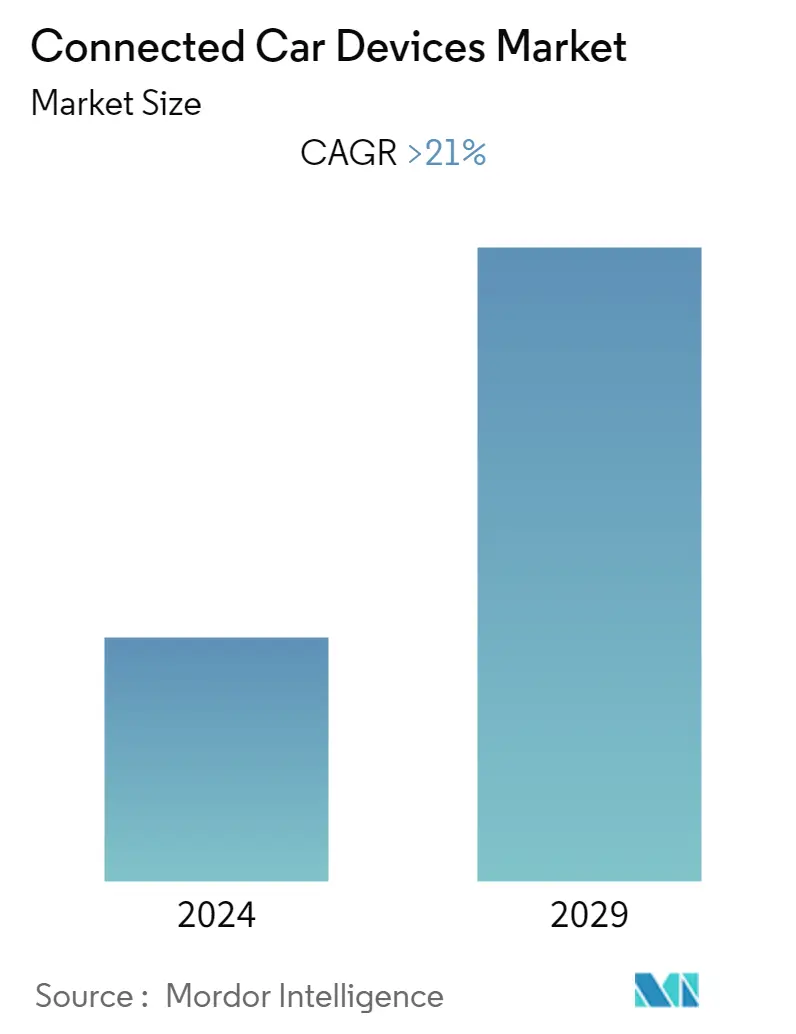Market Size of Connected Car Devices Industry

| Study Period | 2019 - 2029 |
| Base Year For Estimation | 2023 |
| CAGR | > 21.00 % |
| Fastest Growing Market | Asia Pacific |
| Largest Market | Asia Pacific |
| Market Concentration | High |
Major Players
*Disclaimer: Major Players sorted in no particular order |
Connected Car Devices Market Analysis
The connected car device market was valued at USD 11.6 billion in 2021 and is expected to reach USD 34.13 billion by 2027, registering a CAGR of over 21% during the forecast period (2022 - 2027).
The COVID-19 pandemic had a severe effect on the market owing to the slowdown of the global automotive industry. The lockdown norms implemented across the world, have severely impacted the market. However, the increasing electrification and self-driving cars are driving the demand for connected cars in the industry.
Connected car devices essentially assist in monitoring vehicles and drivers. Various sensors embedded into the vehicles provide an opportunity to monitor the vehicle's health. This enables the owners to get predictive maintenance for the vehicles without any hiccups. This technology is extremely useful for commercial fleet operators and owners. It helps them maintain a high run-time and low downtime or maintenance time, reducing the scope for losing out on revenue due to vehicle repairs.
The major factors that are driving the market are the increasing occurrences of vehicle theft, and a robust spike in the number of road accidents, particularly due to unsafe driving habits, such as over-speeding, hard cornering, and unmanageably dense traffic. Apart from the aforementioned drivers, vehicle connectivity has also gained traction, due to the preference of in-car Wi-Fi hotspots and data services, for providing infotainment facilities.
Vehicle automation presents the most lucrative opportunity for connected car devices, which provide the necessary (initial) inter- and intra-vehicle communication and response infrastructure, to facilitate autonomous capabilities.
Connected Car Devices Industry Segmentation
The Connected Car Devices Market is segmented by End-user Type (OEM and Aftermarket), Communication Type (V2V, V2I, and V2P), Product Type (Driver Assistance System and Telematics), Vehicle Type (IC Engine, Electric, and Fuel Cell Vehicle), and by Geography (North America, Europe, Asia-Pacific, and Rest of the World). The report offers market size and forecast for connected car devices in terms of value (USD Million) for all the above segments.
| End-user Type | |
| OEM | |
| Aftermarket |
| Communication Type | |
| V2V | |
| V2I | |
| V2P |
| Product Type | |
| Driver Assistance System (DAS) | |
| Telematics |
| Vehicle Type | |||||
| IC Engine | |||||
|
| Geography | |||||||
| |||||||
| |||||||
| |||||||
|
Connected Car Devices Market Size Summary
The connected car devices market is experiencing significant growth, driven by the increasing electrification and automation within the automotive industry. These devices play a crucial role in monitoring vehicle health and enhancing driver safety through advanced sensors and connectivity features. The demand for connected cars is further propelled by the rising need for vehicle security, accident prevention, and the integration of in-car Wi-Fi and infotainment services. The market is also benefiting from the growing trend towards vehicle automation, which requires robust inter- and intra-vehicle communication systems. This technological advancement is supported by substantial investments from automakers in electric and autonomous vehicles, as well as favorable government regulations promoting connected and automated driving solutions.
Regionally, Europe and North America are expected to lead the connected car device market, with the United States taking a pioneering role in vehicle connectivity initiatives. The European Union's regulations, such as the mandatory e-call systems, are enhancing vehicle safety and increasing the adoption of connected vehicle technologies. In the Asia-Pacific region, China is at the forefront, driven by consumer demand for embedded connectivity and a shift towards connected vehicles. Key industry players, including Continental AG, Robert Bosch GmbH, and Denso Corporation, are actively developing advanced technologies and forming strategic partnerships to maintain a competitive edge. The market is also witnessing the entry of new players, offering substantial growth opportunities as they expand to meet the rising demand for connected car devices.
Connected Car Devices Market Size - Table of Contents
-
1. MARKET DYNAMICS
-
1.1 Market Drivers
-
1.2 Market Restraints
-
1.3 Industry Attractiveness - Porter's Five Forces Analysis
-
1.3.1 Threat of New Entrants
-
1.3.2 Bargaining Power of Buyers/Consumers
-
1.3.3 Bargaining Power of Suppliers
-
1.3.4 Threat of Substitute Products
-
1.3.5 Intensity of Competitive Rivalry
-
-
-
2. MARKET SEGMENTATION
-
2.1 End-user Type
-
2.1.1 OEM
-
2.1.2 Aftermarket
-
-
2.2 Communication Type
-
2.2.1 V2V
-
2.2.2 V2I
-
2.2.3 V2P
-
-
2.3 Product Type
-
2.3.1 Driver Assistance System (DAS)
-
2.3.2 Telematics
-
-
2.4 Vehicle Type
-
2.4.1 IC Engine
-
2.4.2 Electric
-
2.4.2.1 Battery Electric Vehicle
-
2.4.2.2 Hybrid Electric Vehicle
-
2.4.2.3 Fuel Cell Vehicle
-
-
-
2.5 Geography
-
2.5.1 North America
-
2.5.1.1 United States
-
2.5.1.2 Canada
-
2.5.1.3 Rest of North America
-
-
2.5.2 Europe
-
2.5.2.1 Germany
-
2.5.2.2 United Kingdom
-
2.5.2.3 France
-
2.5.2.4 Spain
-
2.5.2.5 Rest of Europe
-
-
2.5.3 Asia-Pacific
-
2.5.3.1 China
-
2.5.3.2 Japan
-
2.5.3.3 India
-
2.5.3.4 Rest of Asia-Pacific
-
-
2.5.4 Rest of the World
-
2.5.4.1 South America
-
2.5.4.2 Middle East & Africa
-
-
-
Connected Car Devices Market Size FAQs
What is the current Connected Car Devices Market size?
The Connected Car Devices Market is projected to register a CAGR of greater than 21% during the forecast period (2024-2029)
Who are the key players in Connected Car Devices Market?
Continental AG, Denso Corporation, Robert Bosch GmbH, Autoliv Inc. and Valeo SA are the major companies operating in the Connected Car Devices Market.

